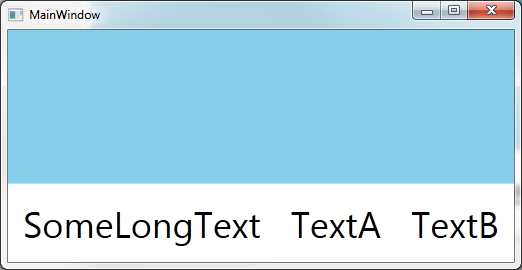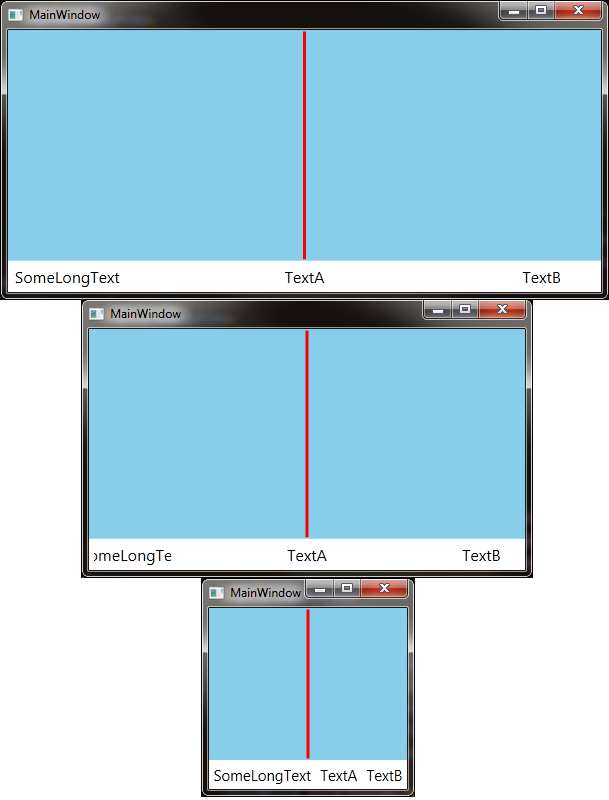

我在网格中的WPF中有几个TextBlock,我想根据它们的可用宽度/高度进行缩放。当我搜索自动缩放字体大小时,典型的建议是将TextBlock放入ViewBox中。
所以我这样做了:
<Grid>
<Grid.ColumnDefinitions>
<ColumnDefinition Width="*" />
<ColumnDefinition Width="*" />
<ColumnDefinition Width="*" />
</Grid.ColumnDefinitions>
<Viewbox MaxHeight="18" Grid.Column="0" Stretch="Uniform" Margin="5" HorizontalAlignment="Stretch" VerticalAlignment="Stretch">
<TextBlock Text="{Binding Text1}" />
</Viewbox>
<Viewbox MaxHeight="18" Grid.Column="1" Stretch="Uniform" Margin="5" HorizontalAlignment="Stretch" VerticalAlignment="Stretch">
<TextBlock Text="{Binding Text2}" />
</Viewbox>
<Viewbox MaxHeight="18" Grid.Column="2" Stretch="Uniform" Margin="5" HorizontalAlignment="Stretch" VerticalAlignment="Stretch">
<TextBlock Text="{Binding Text3}" />
</Viewbox>
</Grid>
它会自动缩放每个文本块的字体。然而,这看起来很有趣,因为如果其中一个文本块有较长的文本,那么它将使用较小的字体,而其相邻的网格元素将使用较大的字体。我希望字体大小按组缩放,如果我能为一组控件指定一个“SharedSizeGroup”来自动调整它们的字体大小,那就更好了。
例如
第一个文本块文本可能是“3/26/2013 10:45:30 AM”,第二个文本块文本可能显示“文件名.ext”。如果这些是跨窗口的宽度,并且用户开始将窗口大小越来越小。日期将开始使其字体小于文件名,具体取决于文件名的长度。
理想情况下,一旦其中一个文本字段开始调整字体点大小,它们都将匹配。有人想出了解决方案吗?或者可以给我一个机会,告诉我你将如何使它工作?如果它需要自定义代码,那么希望我们/我可以将其重新打包成自定义混合或附加行为,以便将来可重用。我认为这是一个相当普遍的问题,但我无法通过搜索在上面找到任何东西。
更新我尝试了Mathieu的建议,它有点奏效,但它有一些副作用:
<Window x:Class="WpfApplication6.MainWindow"
xmlns="http://schemas.microsoft.com/winfx/2006/xaml/presentation"
xmlns:x="http://schemas.microsoft.com/winfx/2006/xaml"
Title="MainWindow" Height="270" Width="522">
<Grid>
<Grid.RowDefinitions>
<RowDefinition Height="*"/>
<RowDefinition Height="Auto" />
</Grid.RowDefinitions>
<Rectangle Grid.Row="0" Fill="SkyBlue" />
<Viewbox Grid.Row="1" MaxHeight="30" Stretch="Uniform" HorizontalAlignment="Stretch" VerticalAlignment="Stretch" >
<Grid>
<Grid.ColumnDefinitions>
<ColumnDefinition Width="Auto" SharedSizeGroup="col"/>
<ColumnDefinition Width="Auto" SharedSizeGroup="col"/>
<ColumnDefinition Width="Auto" SharedSizeGroup="col"/>
</Grid.ColumnDefinitions>
<TextBlock Grid.Column="0" Text="SomeLongText" Margin="5" />
<TextBlock Grid.Column="1" Text="TextA" Margin="5" />
<TextBlock Grid.Column="2" Text="TextB" Margin="5" />
</Grid>
</Viewbox>
</Grid>
</Window>

老实说,缺少比例列对我来说可能没问题。我不介意自动调整列大小以巧妙地利用空间,但它必须跨越窗口的整个宽度。
注意没有maxsize,在这个扩展的例子中文本太大了:
<Window x:Class="WpfApplication6.MainWindow"
xmlns="http://schemas.microsoft.com/winfx/2006/xaml/presentation"
xmlns:x="http://schemas.microsoft.com/winfx/2006/xaml"
Title="MainWindow" Height="270" Width="522">
<Grid>
<Grid.RowDefinitions>
<RowDefinition Height="*"/>
<RowDefinition Height="Auto" />
</Grid.RowDefinitions>
<Rectangle Grid.Row="0" Fill="SkyBlue" />
<Viewbox Grid.Row="1" Stretch="Uniform" HorizontalAlignment="Stretch" VerticalAlignment="Stretch" >
<Grid>
<Grid.ColumnDefinitions>
<ColumnDefinition Width="Auto" SharedSizeGroup="col"/>
<ColumnDefinition Width="Auto" SharedSizeGroup="col"/>
<ColumnDefinition Width="Auto" SharedSizeGroup="col"/>
</Grid.ColumnDefinitions>
<TextBlock Grid.Column="0" Text="SomeLongText" Margin="5" />
<TextBlock Grid.Column="1" Text="TextA" Margin="5" />
<TextBlock Grid.Column="2" Text="TextB" Margin="5" />
</Grid>
</Viewbox>
</Grid>

在这里,我想限制字体可以变得多大,这样它就不会浪费垂直窗口空间。我希望输出向左、居中和向右对齐,字体尽可能大,直到所需的最大大小。
@adabyron
你提出的解决方案还不错(而且是目前最好的),但它确实有一些局限性。例如,最初我希望我的列是成比例的(第二列应该居中)。例如,我的TextBlocks可能会标记对齐很重要的图形的开始、中心和停止。
<Window x:Class="WpfApplication6.Window1"
xmlns="http://schemas.microsoft.com/winfx/2006/xaml/presentation"
xmlns:x="http://schemas.microsoft.com/winfx/2006/xaml"
xmlns:i="http://schemas.microsoft.com/expression/2010/interactivity"
xmlns:b="clr-namespace:WpfApplication6.Behavior"
Title="MainWindow" Height="350" Width="525">
<Grid>
<Grid.RowDefinitions>
<RowDefinition Height="*"/>
<RowDefinition Height="Auto" />
</Grid.RowDefinitions>
<Rectangle Grid.Row="0" Fill="SkyBlue" />
<Line X1="0.5" X2="0.5" Y1="0" Y2="1" Stretch="Fill" StrokeThickness="3" Stroke="Red" />
<Grid Grid.Row="1">
<i:Interaction.Behaviors>
<b:MoveToViewboxBehavior />
</i:Interaction.Behaviors>
<Viewbox Stretch="Uniform" />
<ContentPresenter >
<ContentPresenter.Content>
<Grid x:Name="TextBlockContainer">
<Grid.Resources>
<Style TargetType="TextBlock" >
<Setter Property="FontSize" Value="16" />
<Setter Property="Margin" Value="5" />
</Style>
</Grid.Resources>
<Grid.ColumnDefinitions>
<ColumnDefinition Width="*" />
<ColumnDefinition Width="*" />
<ColumnDefinition Width="*" />
<ColumnDefinition Width="*" />
<ColumnDefinition Width="*" />
</Grid.ColumnDefinitions>
<TextBlock Grid.Column="0" Text="SomeLongText" VerticalAlignment="Center" HorizontalAlignment="Center" />
<TextBlock Grid.Column="2" Text="TextA" HorizontalAlignment="Center" VerticalAlignment="Center" />
<TextBlock Grid.Column="4" Text="TextB" HorizontalAlignment="Center" VerticalAlignment="Center" />
</Grid>
</ContentPresenter.Content>
</ContentPresenter>
</Grid>
</Grid>
</Window>
这就是结果。请注意,它不知道它在早期被剪裁,然后当它替换ViewBox时,它看起来就像网格默认为列大小“自动”,不再居中对齐。

我想编辑我已经提供的答案,但后来决定发布一个新答案更有意义,因为这实际上取决于我更喜欢哪一个的要求。这可能更符合艾伦的想法,因为

另一个的优点是
我也在StackPanel/DockPanel类型的顶部容器中测试了这个解决方案,表现不错。
请注意,通过调整列/行宽/高度(自动/星形大小),您可以获得不同的行为。因此,也可以将所有三个文本块列设置为星形,但这意味着宽度剪切确实发生得更早,并且有更多的边距。或者,如果网格所在的行是自动调整大小的,则永远不会发生高度裁剪。
Xaml:
<Window x:Class="WpfApplication1.MainWindow"
xmlns="http://schemas.microsoft.com/winfx/2006/xaml/presentation"
xmlns:x="http://schemas.microsoft.com/winfx/2006/xaml"
xmlns:i="http://schemas.microsoft.com/expression/2010/interactivity"
xmlns:beh="clr-namespace:WpfApplication1.Behavior"
Title="MainWindow" Height="350" Width="525">
<Grid>
<Grid.RowDefinitions>
<RowDefinition Height="0.9*"/>
<RowDefinition Height="0.1*" />
</Grid.RowDefinitions>
<Rectangle Fill="DarkOrange" />
<Grid x:Name="TextBlockContainer" Grid.Row="1" >
<i:Interaction.Behaviors>
<beh:ScaleFontBehavior MaxFontSize="32" />
</i:Interaction.Behaviors>
<Grid.Resources>
<Style TargetType="TextBlock" >
<Setter Property="Margin" Value="5" />
<Setter Property="VerticalAlignment" Value="Center" />
</Style>
</Grid.Resources>
<Grid.ColumnDefinitions>
<ColumnDefinition Width="*" />
<ColumnDefinition Width="Auto" />
<ColumnDefinition Width="*" />
</Grid.ColumnDefinitions>
<TextBlock Grid.Column="0" Text="SomeLongText" />
<TextBlock Grid.Column="1" Text="TextA" HorizontalAlignment="Center" />
<TextBlock Grid.Column="2" Text="TextB" HorizontalAlignment="Right" />
</Grid>
</Grid>
</Window>
缩放字体行为:
using System;
using System.Collections.Generic;
using System.Globalization;
using System.Windows;
using System.Windows.Controls;
using System.Windows.Interactivity;
using System.Windows.Media;
using WpfApplication1.Helpers;
namespace WpfApplication1.Behavior
{
public class ScaleFontBehavior : Behavior<Grid>
{
// MaxFontSize
public double MaxFontSize { get { return (double)GetValue(MaxFontSizeProperty); } set { SetValue(MaxFontSizeProperty, value); } }
public static readonly DependencyProperty MaxFontSizeProperty = DependencyProperty.Register("MaxFontSize", typeof(double), typeof(ScaleFontBehavior), new PropertyMetadata(20d));
protected override void OnAttached()
{
this.AssociatedObject.SizeChanged += (s, e) => { CalculateFontSize(); };
}
private void CalculateFontSize()
{
double fontSize = this.MaxFontSize;
List<TextBlock> tbs = VisualHelper.FindVisualChildren<TextBlock>(this.AssociatedObject);
// get grid height (if limited)
double gridHeight = double.MaxValue;
Grid parentGrid = VisualHelper.FindUpVisualTree<Grid>(this.AssociatedObject.Parent);
if (parentGrid != null)
{
RowDefinition row = parentGrid.RowDefinitions[Grid.GetRow(this.AssociatedObject)];
gridHeight = row.Height == GridLength.Auto ? double.MaxValue : this.AssociatedObject.ActualHeight;
}
foreach (var tb in tbs)
{
// get desired size with fontsize = MaxFontSize
Size desiredSize = MeasureText(tb);
double widthMargins = tb.Margin.Left + tb.Margin.Right;
double heightMargins = tb.Margin.Top + tb.Margin.Bottom;
double desiredHeight = desiredSize.Height + heightMargins;
double desiredWidth = desiredSize.Width + widthMargins;
// adjust fontsize if text would be clipped vertically
if (gridHeight < desiredHeight)
{
double factor = (desiredHeight - heightMargins) / (this.AssociatedObject.ActualHeight - heightMargins);
fontSize = Math.Min(fontSize, MaxFontSize / factor);
}
// get column width (if limited)
ColumnDefinition col = this.AssociatedObject.ColumnDefinitions[Grid.GetColumn(tb)];
double colWidth = col.Width == GridLength.Auto ? double.MaxValue : col.ActualWidth;
// adjust fontsize if text would be clipped horizontally
if (colWidth < desiredWidth)
{
double factor = (desiredWidth - widthMargins) / (col.ActualWidth - widthMargins);
fontSize = Math.Min(fontSize, MaxFontSize / factor);
}
}
// apply fontsize (always equal fontsizes)
foreach (var tb in tbs)
{
tb.FontSize = fontSize;
}
}
// Measures text size of textblock
private Size MeasureText(TextBlock tb)
{
var formattedText = new FormattedText(tb.Text, CultureInfo.CurrentUICulture,
FlowDirection.LeftToRight,
new Typeface(tb.FontFamily, tb.FontStyle, tb.FontWeight, tb.FontStretch),
this.MaxFontSize, Brushes.Black); // always uses MaxFontSize for desiredSize
return new Size(formattedText.Width, formattedText.Height);
}
}
}
VisualHelper:
public static List<T> FindVisualChildren<T>(DependencyObject obj) where T : DependencyObject
{
List<T> children = new List<T>();
for (int i = 0; i < VisualTreeHelper.GetChildrenCount(obj); i++)
{
var o = VisualTreeHelper.GetChild(obj, i);
if (o != null)
{
if (o is T)
children.Add((T)o);
children.AddRange(FindVisualChildren<T>(o)); // recursive
}
}
return children;
}
public static T FindUpVisualTree<T>(DependencyObject initial) where T : DependencyObject
{
DependencyObject current = initial;
while (current != null && current.GetType() != typeof(T))
{
current = VisualTreeHelper.GetParent(current);
}
return current as T;
}
将您的网格放入视图框,这将缩放整个网格:
<Viewbox Stretch="Uniform" HorizontalAlignment="Stretch" VerticalAlignment="Stretch">
<Grid>
<Grid.ColumnDefinitions>
<ColumnDefinition Width="*" />
<ColumnDefinition Width="*" />
<ColumnDefinition Width="*" />
</Grid.ColumnDefinitions>
<TextBlock Grid.Column="0" Text="{Binding Text1}" Margin="5" />
<TextBlock Grid.Column="1" Text="{Binding Text2}" Margin="5" />
<TextBlock Grid.Column="2" Text="{Binding Text3}" Margin="5" />
</Grid>
</Viewbox>
我想我知道该怎么走,剩下的就交给你了。在这个例子中,我使用一个转换器(转换器如下)将FontSize绑定到TextBlock的实际高度:
<Window x:Class="MyNamespace.Test"
xmlns="http://schemas.microsoft.com/winfx/2006/xaml/presentation"
xmlns:x="http://schemas.microsoft.com/winfx/2006/xaml" xmlns:Converters="clr-namespace:UpdateYeti.Converters"
Title="Test" Height="570" Width="522">
<Grid Height="370" Width="522">
<Grid.Resources>
<Converters:HeightToFontSizeConverter x:Key="conv" />
</Grid.Resources>
<Grid.RowDefinitions>
<RowDefinition Height="*"/>
<RowDefinition Height="Auto" />
</Grid.RowDefinitions>
<Rectangle Grid.Row="0" Fill="SkyBlue" />
<Grid Grid.Row="1" HorizontalAlignment="Stretch" VerticalAlignment="Stretch" MinHeight="60" Background="Beige">
<Grid.ColumnDefinitions>
<ColumnDefinition Width="Auto" />
<ColumnDefinition Width="*" />
<ColumnDefinition Width="Auto" />
</Grid.ColumnDefinitions>
<TextBlock Grid.Column="0" Text="SomeLongText" Margin="5"
FontSize="{Binding RelativeSource={RelativeSource Self}, Path=ActualHeight, Converter={StaticResource conv}}" />
<TextBlock Grid.Column="1" Text="TextA" Margin="5" HorizontalAlignment="Center"
FontSize="{Binding RelativeSource={RelativeSource Self}, Path=ActualHeight, Converter={StaticResource conv}}" />
<TextBlock Grid.Column="2" Text="TextB" Margin="5" FontSize="{Binding RelativeSource={RelativeSource Self}, Path=ActualHeight, Converter={StaticResource conv}}" />
</Grid>
</Grid>
</Window>
[ValueConversion(typeof(double), typeof(double))]
class HeightToFontSizeConverter : IValueConverter
{
public object Convert(object value, Type targetType, object parameter, CultureInfo culture)
{
// here you can use the parameter that you can give in here via setting , ConverterParameter='something'} or use any nice login with the VisualTreeHelper to make a better return value, or maybe even just hardcode some max values if you like
var height = (double)value;
return .65 * height;
}
public object ConvertBack(object value, Type targetType, object parameter, CultureInfo culture)
{
throw new NotImplementedException();
}
}